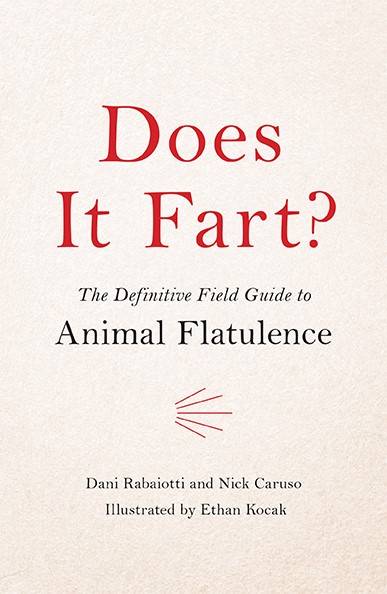 Last week, I learned that another Nick Caruso—a Nick Caruso who is not me— wrote a book called, Does It Fart? The Definitive Field Guide to Animal Flatulence. I jokingly tweeted that I was going to tell all my friends the book was mine because 1) the book’s concept is hysterical and 2) the obvious same-name gag. (Public Service Announcement: It was a JOKE—plagiarism sucks!) Author-Nick, who’s an American ecologist, something I am nowhere close to being in this life, tweeted back and agreed to answer a few questions about….uh, well…farts.
Last week, I learned that another Nick Caruso—a Nick Caruso who is not me— wrote a book called, Does It Fart? The Definitive Field Guide to Animal Flatulence. I jokingly tweeted that I was going to tell all my friends the book was mine because 1) the book’s concept is hysterical and 2) the obvious same-name gag. (Public Service Announcement: It was a JOKE—plagiarism sucks!) Author-Nick, who’s an American ecologist, something I am nowhere close to being in this life, tweeted back and agreed to answer a few questions about….uh, well…farts.
Co-written with Dani Rabaiotti, a zoologist at the Zoological Society of London, and illustrated by Ethan Kocak, Does It Fart? is the ultimate guide to animal flatulence. It’s the book you never knew you needed—a hilarious project spawned from an innocent conversation between strangers on Twitter that turned into a viral hashtag heard (and smelled) around the world. Thanks to the power of Science Twitter, dozens of noted experts began weighing in on which animals do and don’t fart, and if they did, how much, how often, what it’s made of, what it smells like, and why. Alas, the scientifically sound book of animal farts was produced!
TLW: How did you and Dani connect for this project?
Nick Caruso, the author: We have never actually met, we only vaguely knew of each other on Twitter before this all started. We wrote this book over email, Google Docs, Twitter, and Skype.
Where did the idea for the book come from?
Back in January of 2017, Dani’s brother asked her if snakes farted. She didn’t know the answer so she asked David Steen, a snake expert, on Twitter (they do, if you were wondering). After seeing this exchange, I suggested that the hashtag #DoesItFart should be a thing and Dani then suggested that we start a spreadsheet, as the true nature of the science. We invited anyone who had knowledge of any species to contribute to the spreadsheet (yes, no, maybe, etc.) and the hashtag and spreadsheet soon went viral. A short time later, publishers at Quercus emailed us asking if we would like to turn the spreadsheet into a book and we of course said yes. Later, when Quercus mentioned they wanted the book to be illustrated, we both thought of another Science Twitter friend and talented illustrator Ethan Kocak (who we have also never actually met).
How does one even begin researching animal flatulence? What are the best sources?
We had many great contributions to the spreadsheet from Science Twitter, which helped us get started. Firsthand knowledge from scientists, zookeepers, or people familiar with a given species was a great source because it often came with additional details of sound, smell, or frequency. However, it was fascinating to be able to find scientific papers that included information on animal farts.
What was the most shocking thing you learned while compiling info for the book?
I think that sloths don’t fart. They absorb the methane produced from their leafy diet through their gut and it is eventually breathed out.
Do sharks fart?
Yes and like many aquatic animals that fart, they can fart to be less buoyant.
Why doesn’t anyone know if spiders fart?
We just haven’t looked (or smelled/listened) closely enough. Hopefully our book has inspired someone to find this answer.
Will there be a Volume 2? If not, do you and Dani plan on working together on something else?
We don’t have plans for a Volume 2 although people have asked about it as we have uncovered more animal fart facts. However, Dani, Ethan, and I are teaming up to write (and illustrate) another book, True or Poo, which will be about gross facts and misconceptions about animals.
Does It Fart? is available now from Hachette Books via Amazon and Barnes and Noble.



I have never enjoyed an interview more.
I saw this and totally thought it was you! HA!
=P